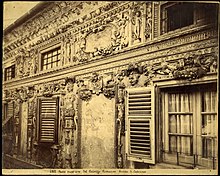|
Palazzo Tommaso Spinola
The Palazzo Tommaso Spinola, also known as Palazzo Tomaso Spinola di Luccoli or Palazzo Spinola Pessagno, is a building located in salita di Santa Caterina at number 3 in Genoa, included on 13 July 2006 in the list of the 42 palaces inscribed in the Rolli di Genova that became World Heritage by UNESCO on that date. HistorySituated between the old Spinola di Luccoli square and the Della Rovere square, it was built to a design by the author of the most unpublished palaces of Mannerism in Genoa, Giovan Battista Castello, known as the Bergamasco, between 1558 and 1561 for Tommaso Spinola, who kept the palace for only a few years, selling it in 1574 to Luca Negrone.[1] It was included in the third compass of the Rollo 1664. Counted in the 18th century among the properties of the Pessagno family, who still owned it at the end of the 19th century, the palace is now used as a private residence. DescriptionExterior Bergamasco's «mark», of full Mannerist observance, can be read in the very fine and original design of the portal richly elaborated with female herms set in a decoration of various architectural motifs, supporting a broken tympanum with spiral volutes, executed in white marble by sculptors Giacomo Ponzello and Pompeo Bianchi (1560). However, what is most striking about Bergamasco's decorative work is the relief decoration of the façade, with its fanciful fresco and stucco quadrature, similar to that executed in the same years by Bergamasco in the palazzo Gio. Vincenzo Imperiale in Campetto — built between 1555 and 1560 — and in palazzo Nicolosio Lomellini in Strada Nuova (1558).[3] In contrast to the difficulty of observing it, the decoration of the upper floors of the building shows itself to be extraordinarily elaborate and exceptionally complex, in a superimposition of fantastic beings, monstrous masks, herms in the shape of armour and planetary deities, figures combining clawed legs, fish tails, bird's wings and female faces, with obvious magical and alchemical references extracted from Hermeticism (philosophy).[4] InteriorThe atrium (architecture) is accessible while from the triforium, enclosed with glass windows, only part of the staircase can be seen. The interior is richly frescoed from the atrium to the second floor parlours (Hero in Parnassus by Luca Cambiaso and a similar subject uncertainly attributed to Andrea Semino); in the atrium in particular is a fresco with Andromeda naked exposed to the monster and, in the vault above the entrance to the staircase, Andromeda welcoming Perseus liberator.
Notes
SourcesItalian sources
BibliographyItalian sources
External links
|
||||||||||||||||||||||||||||||||||||||||||||
Portal di Ensiklopedia Dunia





